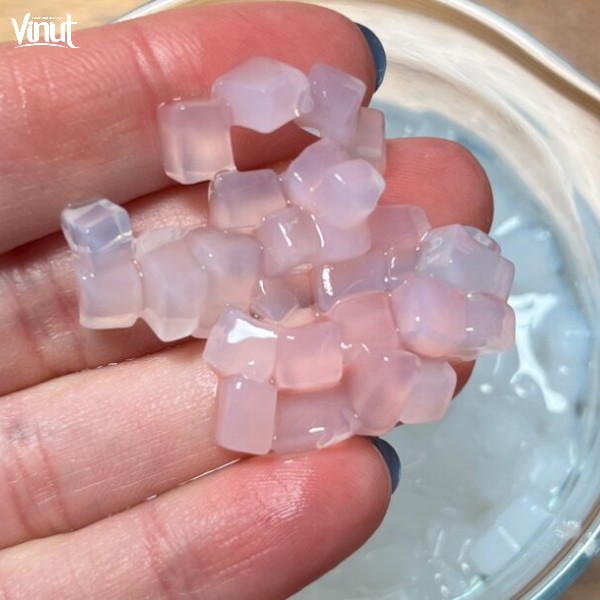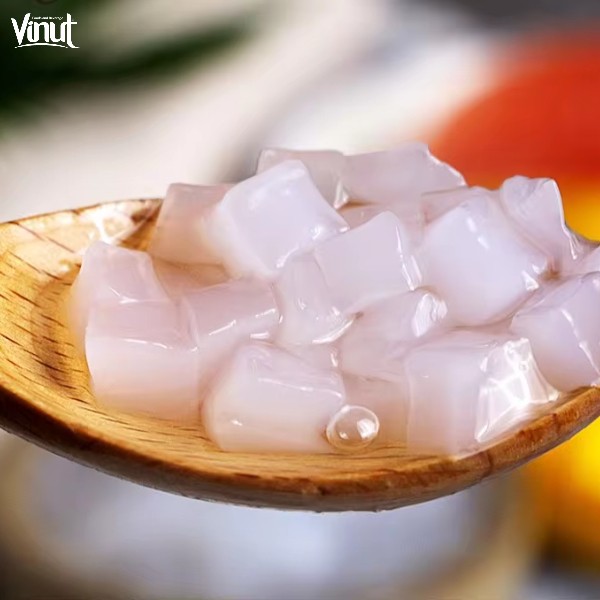
News
Health Benefits of Nata de Coco Jelly Juice

Nata de Coco, a delicious and chewy jelly made from fermented coconut water, has been a favorite in many tropical regions for years. When combined with fruit juices, it becomes a refreshing and health-boosting beverage. This article Cojo Cojo explores the health benefits of Nata de Coco Jelly Juice, its nutritional profile, and various ways to enjoy it in your diet.

What is Nata de Coco?
Nata de Coco, which means “cream of coconut,” originated in the Philippines. It is produced through the fermentation of coconut water using a specific bacterium called Acetobacter xylinum. This process results in a gelatinous, translucent substance that is rich in fiber and has a unique, chewy texture. Nata de Coco is often used in desserts and beverages, adding a delightful twist to many recipes.
Nutritional Profile of Nata de Coco
Nata de Coco is low in calories and fat, making it a healthy addition to various dishes and drinks. It is also high in dietary fiber, which aids in digestion and promotes a healthy gut. The nutritional breakdown of Nata de Coco typically includes:
- Calories: Approximately 30 calories per serving (100 grams)
- Dietary Fiber: Around 2 grams per serving
- Carbohydrates: About 7 grams per serving
- Fat: Less than 0.2 grams per serving
- Protein: Less than 0.1 grams per serving
- Vitamins and Minerals: Contains small amounts of calcium, potassium, and vitamin C
Health Benefits of Nata de Coco Jelly Juice
Rich in Dietary Fiber
One of the standout benefits of Nata de Coco is its high dietary fiber content. Dietary fiber is essential for maintaining a healthy digestive system. It helps regulate bowel movements, prevents constipation, and promotes overall gut health.
Low in Calories
For those looking to maintain or lose weight, Nata de Coco Jelly Juice is an excellent choice. It is low in calories, making it a guilt-free addition to your diet. You can enjoy the refreshing taste and texture without worrying about excessive calorie intake.
Aids in Digestion
The fiber content in Nata de Coco not only supports regular bowel movements but also helps in the digestion of food. This can be particularly beneficial for individuals with digestive issues, as it can ease the process of digestion and reduce symptoms of bloating and discomfort.

Supports Hydration
Nata de Coco Jelly Juice is an excellent hydrating beverage, especially when combined with fruit juices. Coconut water, the base of Nata de Coco, is known for its hydrating properties due to its high electrolyte content. This makes Nata de Coco Jelly Juice a great choice for rehydrating after exercise or on a hot day.
Boosts Heart Health
The fiber in Nata de Coco can also contribute to heart health. Dietary fiber helps to lower cholesterol levels, reducing the risk of heart disease. Additionally, the potassium in coconut water can help regulate blood pressure, further supporting cardiovascular health.
Promotes Healthy Skin
The vitamins and minerals present in Nata de Coco, such as vitamin C and potassium, are beneficial for skin health. Vitamin C is known for its antioxidant properties, which can help protect the skin from damage caused by free radicals. Potassium helps maintain proper hydration levels in the skin, keeping it plump and healthy.
How Nata de Coco Jelly Juice is Made
Ingredients
To make Nata de Coco Jelly Juice, you will need the following ingredients:
- Fresh coconut water
- Sugar
- Acetic acid (vinegar)
- Nata de Coco bacterial culture (Acetobacter xylinum)
- Fruit juices of your choice (e.g., mango, pineapple, lychee)

Fermentation Process
- Preparing the Coconut Water: Fresh coconut water is extracted from mature coconuts and filtered to remove any impurities.
- Adding the Bacterial Culture: Sugar and acetic acid are added to the coconut water to create a suitable environment for fermentation. The Nata de Coco bacterial culture is then introduced to the mixture.
- Fermentation Period: The mixture is left to ferment for 14 to 21 days at a controlled temperature. During this time, the bacteria convert the coconut water into a gelatinous substance, forming Nata de Coco.
Harvesting and Preparation
- Harvesting: After fermentation, the gelatinous layer is harvested from the top of the mixture.
- Cutting and Washing: The Nata de Coco is cut into small cubes and thoroughly washed to remove any residual acetic acid and impurities.
- Cooking and Sweetening: The washed Nata de Coco is cooked in water and sweetened with sugar syrup to enhance its flavor.
Different Ways to Enjoy Nata de Coco Jelly Juice
As a Standalone Drink
Nata de Coco Jelly Juice can be enjoyed on its own as a refreshing beverage. Simply combine the prepared Nata de Coco cubes with your favorite fruit juice and enjoy the chewy texture and delightful flavor.
In Smoothies
Adding Nata de Coco to smoothies is a great way to boost their nutritional content and add an interesting texture. Blend your favorite fruits with some yogurt or milk, and stir in Nata de Coco cubes for a satisfying and nutritious smoothie.
In Desserts
Nata de Coco can be used in various desserts, such as fruit salads, jellies, and puddings. Its chewy texture complements the softness of other dessert components, creating a delightful contrast.

With Fresh Fruit
For a simple and healthy snack, combine Nata de Coco with fresh fruit pieces. This combination is not only delicious but also packed with vitamins, minerals, and fiber.
Popular Variations of Nata de Coco Jelly Juice
Tropical Fruit Mix
A tropical fruit mix combines the flavors of pineapple, mango, and passion fruit with Nata de Coco. This refreshing drink is perfect for hot summer days and provides a burst of tropical goodness in every sip.
Lychee and Nata de Coco
Lychee and Nata de Coco make a delightful combination, with the sweet and floral notes of lychee blending seamlessly with the chewy texture of Nata de Coco. This variation is often enjoyed chilled and is a popular choice in many Asian countries.
Mango Delight
Mango juice mixed with Nata de Coco creates a rich and creamy beverage that is both satisfying and refreshing. The sweetness of the mango pairs perfectly with the subtle flavor and texture of Nata de Coco, making it a favorite among mango lovers.

Tips for Incorporating Nata de Coco Jelly Juice into Your Diet
- Start with Small Portions: If you are new to Nata de Coco, start with small portions to see how your body reacts to the high fiber content.
- Combine with Different Juices: Experiment with different fruit juices to find your favorite flavor combinations.
- Use as a Dessert Topping: Add Nata de Coco to ice cream, yogurt, or other desserts for an extra layer of texture and flavor.
- Stay Hydrated: Nata de Coco Jelly Juice is a great way to stay hydrated, especially during hot weather or after physical activity.
- Enjoy as a Snack: Keep a jar of Nata de Coco Jelly Juice in the refrigerator for a quick and healthy snack.
Potential Side Effects and Considerations
While Nata de Coco Jelly Juice is generally safe and healthy, there are a few considerations to keep in mind:
- High Fiber Content: The high fiber content in Nata de Coco can cause digestive discomfort if consumed in large quantities. Start with small portions and gradually increase your intake.
- Added Sugars: Some commercial Nata de Coco products may contain added sugars. Opt for natural or low-sugar options if you are watching your sugar intake.
- Allergies: Although rare, some individuals may be allergic to coconut products. If you experience any allergic reactions, discontinue use and consult a healthcare professional.
Conclusion
Nata de Coco Jelly Juice is a delicious and nutritious beverage that offers numerous health benefits. From aiding digestion and supporting hydration to promoting heart health and healthy skin, this unique drink is a great addition to any diet. With its versatile use in various recipes and easy preparation, Nata de Coco Jelly Juice is sure to become a favorite in your household.
FAQs
1. What is Nata de Coco made from?
- Nata de Coco is made from fermented coconut water using the bacterium Acetobacter xylinum.
2. How long does it take to make Nata de Coco?
- The fermentation process for Nata de Coco typically takes about 14 to 21 days.
3. Can I make Nata de Coco at home?
- Yes, Nata de Coco can be made at home with the right ingredients and proper fermentation setup.
4. What are the health benefits of Nata de Coco?
- Nata de Coco is low in calories, high in dietary fiber, and contains essential minerals like calcium and potassium.
5. How should Nata de Coco Jelly Juice be stored?
- It should be stored in the refrigerator in an airtight container and is best consumed within a week.











